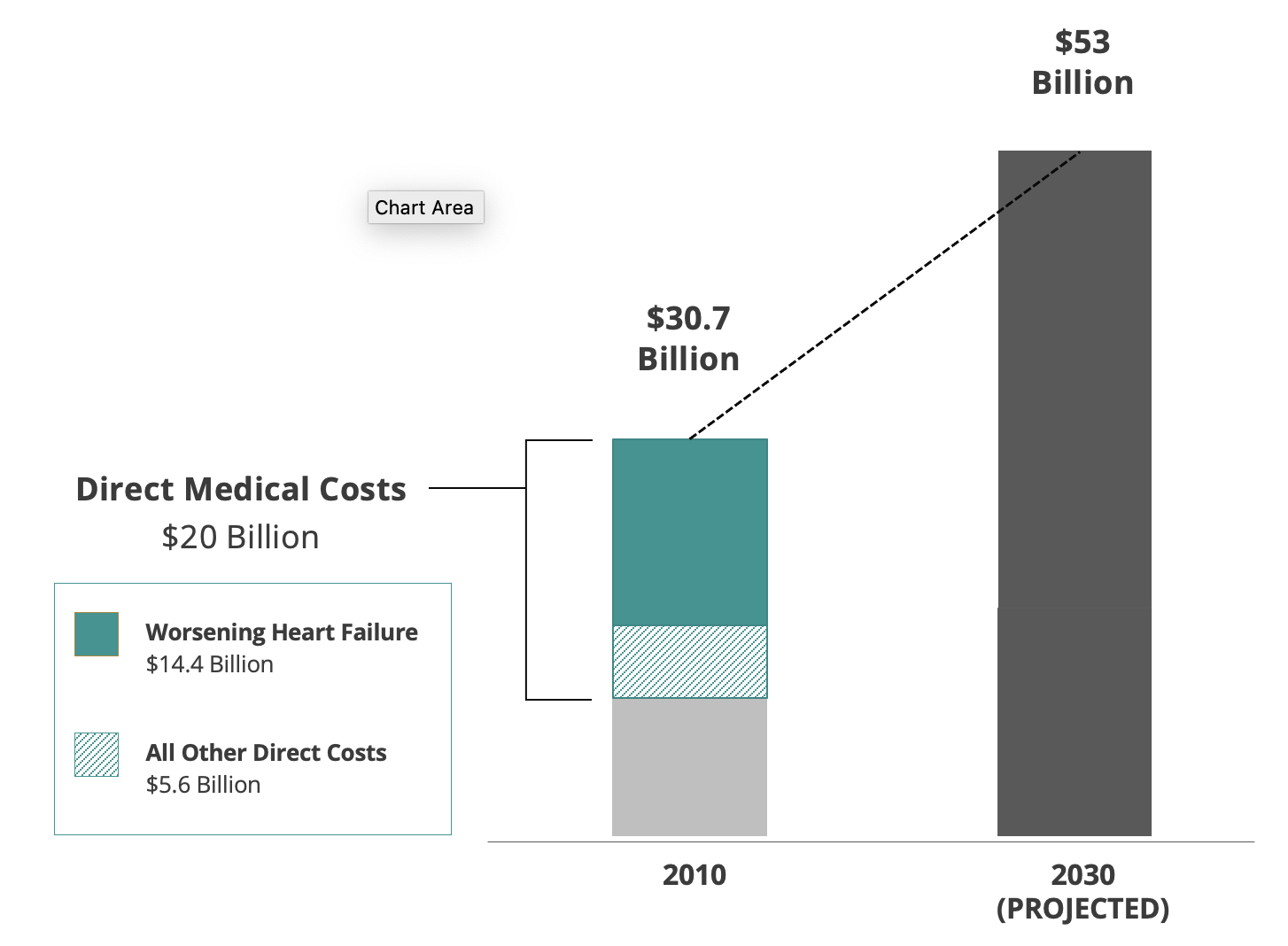The Economics of Heart Failure
The Cost of Heart Failure in the U.S.
Direct Heart Failure Costs $20 Billion
The American Heart Association estimated in 2012 that the total cost of HF to be $30.7 billion (2010 dollars).
About $20 billion, or two-thirds, of this cost is attributable to direct medical costs, such as hospital stays, office visits, and medication.
Projections suggest that by 2030 the total cost of HF will increase by 127%, to $69.8 billion, amounting to ≈$244 for every US adult.


Worsening Heart Failure Costs $14 Billion
The cost of worsening heart failure makes up a large proportion of the direct medical cost.
Because heart failure is almost exclusively a condition of the elderly, the burden for the direct costs is for those who provide medical benefits for the elderly, such as Medicare in the U.S.
In March 2017, Milliman published a report on the cost of worsening heart failure. This report puts the 2015 cost for worsening heart failure at $14.4 billion.
The $14.4 billion in medical cost incurred by Medicare is the number that our treatment, if approved, may impact.
A Background on Payments in the U.S.
Medicare Payments for Worsening Heart Failure
Relevant for this new treatment is how hospitals get paid for treating patients with worsening heart failure.
In 1983 in the U.S., Medicare adopted a new payment system known as the Inpatient Prospective Payment System (IPPS).
Under the IPPS, predefined payment amounts are made to a hospital for the care of a patient based on the primary diagnosis combined with certain characteristics of the patient, such as secondary diagnosis(es), comorbidities and complications, the patient’s age and sex, and if certain procedures were performed. This is called a Diagnostic-Related Group (DRG). The payments are required regardless of the actual length of stay.
So, in general, a DRG payment covers all charges associated with an inpatient stay from the time of admission to discharge, regardless of the length of the actual stay.
This removed the incentives for hospitals to keep the patients longer.
Readmission Rate Causation & Costs
In the U.S., since the incentives for hospitals to keep the patients longer due to DRGs were removed, the IPPS resulted in a marked reduction in length of stay.
Currently, the average length of an in-patient hospital stay for worsening heart failure is 3-5 days.
Resolving edema through diuresis takes time, but many patients now leave the hospitals with considerable residual fluid overload.
This residual fluid overload is blamed for the high readmission rates that have plagued the U.S. and other countries with short average duration of stays. Readmissions occur in about one in every four patients.
A typical patient incurs over $9,000 in charges in the 30 days after discharge. About half of this is for readmissions.
Reducing Total Costs SUBCUTANEOUS DIURETIC TREATMENT
When patients are discharged early and sent home with an Infusor treatment, this does not change the payment amount to the hospital. The payor pays the hospital the same amount as an in-patient stay, but also incurs the cost of the new treatment.
The patient would also incur a co-insurance or co-pay they otherwise would not have had.
Adding to the complexity, if the patient is admitted for less than “two-midnight stays” the episode is considered a short-stay or observation stay. In this case, the hospital does not get to bill under a DRG but can charge a line-item bill. This is comparable to emergency room billing. Patients often have considerable co-insurance payments for these short stays.
Although it is more costly in the short run, discharging a patient from an emergency room visit or observation stay with this treatment may offer a lower cost alternative than a conventional admission. For Medicare, there is a very big difference if the discharge occurs before the second midnight or after.
In-Patient Hospital Furosemide IV Treatment |
| Medicare Payment |
| + |
|
Average of $9,000 in charges (1 in 4 patients are readmitted) |
New Infusor Treatment |
| Same Medicare Payment |
| + |
| Home Infusor Treatment Cost |
European Model
The situation is different in certain European countries where the length of stay is often around 10 days instead of the 3-5 days in the U.S. Readmission rates are generally very low in these countries. Payor systems in these countries, like the NHS in the U.K., are trying to reduce the total hospital beds in a community. This requires reducing overall inpatient days and reducing the length of heart failure inpatient days can contribute to those goals.
Subcutaneous furosemide may offer a way to reduce the length of stay without the quality trade that happens in the U.S. where readmission is common at a high cost.
- 3 – 5 days | Average Length of Hospital Stay in U.S 40%
- 10+ Days | Average Length of Hospital Stay in Europe 100%
